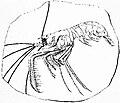| Aeger tipularius Temporal range: | |
|---|---|
 | |
| Aeger tipularius from the Solnhofen Limestone | |
| Scientific classification | |
| Kingdom: | Animalia |
| Phylum: | Arthropoda |
| Class: | Malacostraca |
| Order: | Decapoda |
| Suborder: | Dendrobranchiata |
| Family: | † Aegeridae |
| Genus: | † Aeger |
| Species: | †A. tipularius |
| Binomial name | |
| †Aeger tipularius Schlotheim, 1822 | |
Aeger tipularius is a species of fossil prawn from the Solnhofen Limestone. [1] The Natural History Museum in London has a fossil specimen. [2]

